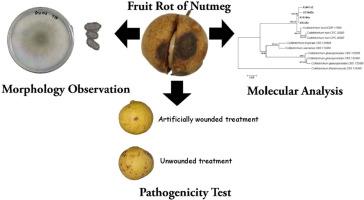Colletotrichum horii causing fruit rot of nutmeg (Myristica fragrans Houtt.) in Malaysia
IF 2.5
2区 农林科学
Q1 AGRONOMY
引用次数: 0
Abstract
Nutmeg (Myristica fragrans Houtt.) is widely cultivated in Malaysia, with Penang being the leading state. During field inspection in 2022, fruit rot disease was observed in several nutmeg orchards, and local growers reported reduced yields. Affected fruits showed black sunken lesions on the surface of nutmeg fruit. To date, this disease has not been reported in Malaysia. A total of 10 nutmeg fruit showing fruit rot disease symptoms were collected from several nutmeg orchards in Penang for fungal isolation. Morphological and molecular approaches, along with pathogenicity tests, were conducted to determine the causal fungal pathogen. Based on morphological characteristics, the fungal isolates were tentatively identified as Colletotrichum species, and molecular analyses using internal transcribed spacer (ITS), glyceraldehyde-3-phosphate dehydrogenase (GAPDH) and actin (ACT) gene loci confirmed the species identity as C. horii. Phylogenetic analyses using both maximum likelihood (ML) and Bayesian inference (BI) methods provided strong support for the species identification, with high bootstrap values (100 %) and Bayesian posterior probabilities (1.0). Pathogenicity tests on 32 healthy immature nutmeg fruits showed that only wounded fruits developed disease symptoms similar to those observed in the field, while non-wounded fruits remained asymptomatic, fulfilling Koch's postulates. This is the first report of C. horii causing fruit rot of nutmeg in Malaysia. These findings provide a foundation for developing targeted disease management strategies to mitigate yield losses in nutmeg cultivation.

马来西亚肉豆蔻(Myristica fragrans Houtt.)果腐病的炭疽菌
肉豆蔻(Myristica fragrans Houtt.)在马来西亚广泛种植,槟城是领先的州。在2022年的实地检查中,在几个肉豆蔻果园观察到果腐病,当地种植者报告产量下降。病果肉豆蔻果表面呈黑色凹陷状病变。迄今为止,马来西亚尚未报告该病。从槟榔屿几个肉豆蔻果园采集了10个有腐果病症状的肉豆蔻果实进行真菌分离。形态学和分子方法,连同致病性试验,进行了确定病原真菌。根据形态特征初步鉴定菌株为炭疽菌属(Colletotrichum),并利用ITS、GAPDH和ACT基因位点进行分子分析,鉴定菌株为炭疽菌属(corii)。采用最大似然(ML)和贝叶斯推理(BI)方法进行系统发育分析,具有较高的自举值(100%)和贝叶斯后验概率(1.0),为物种鉴定提供了强有力的支持。对32个健康的未成熟肉豆蔻果实的致病性测试表明,只有受伤的果实出现了与田间观察到的相似的疾病症状,而未受伤的果实则没有症状,这符合Koch的假设。这是马来西亚首次报道引起肉豆蔻果腐病的horii。这些发现为制定有针对性的疾病管理策略以减轻肉豆蔻种植的产量损失提供了基础。
本文章由计算机程序翻译,如有差异,请以英文原文为准。
求助全文
约1分钟内获得全文
求助全文
来源期刊

Crop Protection
农林科学-农艺学
CiteScore
6.10
自引率
3.60%
发文量
200
审稿时长
29 days
期刊介绍:
The Editors of Crop Protection especially welcome papers describing an interdisciplinary approach showing how different control strategies can be integrated into practical pest management programs, covering high and low input agricultural systems worldwide. Crop Protection particularly emphasizes the practical aspects of control in the field and for protected crops, and includes work which may lead in the near future to more effective control. The journal does not duplicate the many existing excellent biological science journals, which deal mainly with the more fundamental aspects of plant pathology, applied zoology and weed science. Crop Protection covers all practical aspects of pest, disease and weed control, including the following topics:
-Abiotic damage-
Agronomic control methods-
Assessment of pest and disease damage-
Molecular methods for the detection and assessment of pests and diseases-
Biological control-
Biorational pesticides-
Control of animal pests of world crops-
Control of diseases of crop plants caused by microorganisms-
Control of weeds and integrated management-
Economic considerations-
Effects of plant growth regulators-
Environmental benefits of reduced pesticide use-
Environmental effects of pesticides-
Epidemiology of pests and diseases in relation to control-
GM Crops, and genetic engineering applications-
Importance and control of postharvest crop losses-
Integrated control-
Interrelationships and compatibility among different control strategies-
Invasive species as they relate to implications for crop protection-
Pesticide application methods-
Pest management-
Phytobiomes for pest and disease control-
Resistance management-
Sampling and monitoring schemes for diseases, nematodes, pests and weeds.
 求助内容:
求助内容: 应助结果提醒方式:
应助结果提醒方式:


